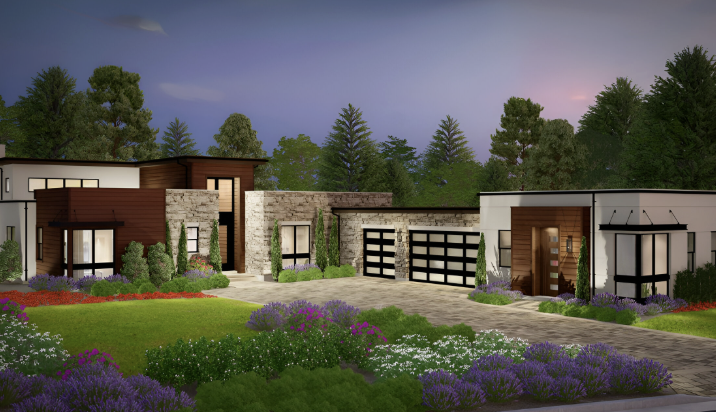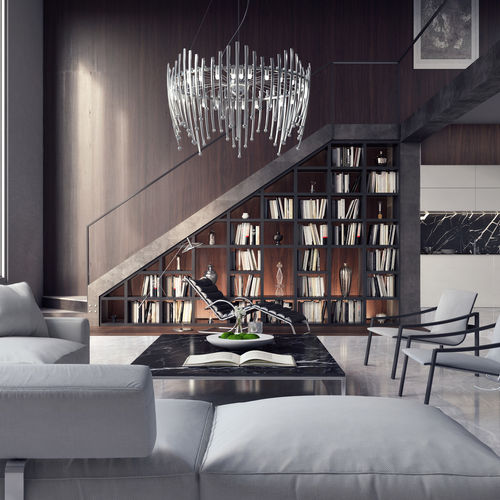Napa County holds more than 400 mid-century modern homes tucked between its famous vineyards, yet most luxury buyers walk past these architectural treasures without recognizing their potential. These homes, built primarily between 1945 and 1965, represent a design philosophy that married indoor-outdoor living with clean lines and functional beauty long before it became mainstream. While everyone focuses on Mediterranean villas and contemporary estates, smart investors are discovering that mid-century modern properties offer something different - a chance to own a piece of architectural history that feels both timeless and refreshingly current. This article reveals why these homes deserve serious consideration for your Napa Valley investment, exploring their unique design elements, the lifestyle they inspire, and how they stand apart in a market saturated with predictable luxury options. You'll learn to identify the key features that make these properties special, understand their architectural significance, and discover why they represent an opportunity to achieve something beyond the ordinary second home purchase. The best part about mid-century modern homes in Napa isn't just their striking aesthetics or their connection to California's design heritage - it's how they encourage you to live differently, to embrace simplicity without sacrificing sophistication. Ready to explore what makes these architectural gems so compelling for discerning buyers who want their investment to inspire rather than simply impress?
Why Mid-Century Modern is Perfect for Napa
Post-war architects revolutionized residential design by creating homes that served multiple purposes without sacrificing visual appeal. These structures eliminated unnecessary ornamentation while maximizing practical living spaces through open floor plans and strategic room placement. Floor-to-ceiling windows became standard features, transforming natural light into a design element that changes throughout the day. Built-in storage solutions and multi-purpose furniture arrangements allowed homeowners to maintain clean lines while accommodating modern lifestyles.
The marriage of form and function reached its peak in these homes through innovative material choices and construction techniques. Architects selected materials not just for their appearance but for their durability and maintenance requirements. Steel beams supported expansive glass walls, creating uninterrupted views while maintaining structural integrity. Flat or low-pitched roofs reduced construction costs and created opportunities for rooftop gardens or outdoor living spaces.
Harmonizing with Napa's Landscape
The design and materials are reductive, focusing on elements that complement rather than compete with the surrounding environment. Native stone foundations anchor these homes to their sites while allowing the structures to appear as natural extensions of the hillsides. Horizontal lines echo the valley's topography, creating visual continuity between built and natural environments.
Large overhangs protect interior spaces from harsh summer sun while welcoming gentle winter light. These architectural features reduce energy consumption and create comfortable outdoor living areas that extend the home's usable space. The seamless integration between indoor and outdoor areas allows residents to experience Napa's climate year-round, whether entertaining guests or enjoying quiet morning coffee.
Luxury buyers increasingly seek properties that offer more than traditional status symbols, driving demand for these architecturally significant homes:
- Architectural Heritage - Owning a piece of California's design history appeals to buyers who appreciate cultural significance alongside investment potential
- Energy Efficiency - Original passive solar specifications and natural ventilation systems reduce utility costs while supporting environmental goals
- Entertaining Spaces - Open floor plans and indoor-outdoor flow create ideal settings for wine country gatherings and events
- Investment Stability - Limited supply of authentic mid-century homes in Napa ensures continued appreciation among discerning collectors
- Lifestyle Alignment - The emphasis on simplicity and connection to nature matches the wellness-focused mindset of many luxury buyers
Choosing a mid-century modern home in Napa means embracing a philosophy that values quality over quantity and substance over superficial luxury. These properties offer refined yet modest aesthetic appeal while providing the sophisticated amenities expected by discerning buyers. The combination of architectural significance, environmental consciousness, and practical luxury creates an ownership experience that satisfies both emotional and financial investment goals.
Key Features of Mid-Century Modern Homes
Distinctive architectural elements define these residences through purposeful design choices that prioritize both visual impact and practical living. Each component works together to create spaces that feel both grand and intimate, where every detail serves a specific function while contributing to the overall aesthetic vision. The genius lies in how these homes achieve maximum effect through minimal means, proving that restraint often produces more powerful results than excess.
Walls disappear between rooms to create flowing spaces that adapt to different activities throughout the day. These barrier-free environments allow natural light to travel unobstructed from one area to another, making even modest square footage feel expansive and welcoming. Floor-to-ceiling glass panels serve as transparent boundaries that maintain visual connections while defining separate zones for cooking, dining, and relaxation. The absence of traditional room divisions means furniture placement becomes the primary tool for creating intimate conversation areas or formal entertaining spaces. This flexibility proves invaluable for luxury buyers who want their homes to accommodate both quiet weekends and large gatherings without feeling cramped or awkward.
Sliding glass doors and retractable wall systems blur the boundaries between interior comfort and exterior beauty. Covered patios extend living rooms into garden settings, while kitchen islands flow seamlessly onto outdoor dining terraces. These transitions happen so naturally that guests often find themselves moving between spaces without conscious thought, creating a sense of freedom that traditional homes rarely achieve. The connection goes beyond mere physical access - interior materials continue onto exterior surfaces, plant life appears in both settings, and sight lines carry the eye from indoor seating areas to distant mountain views. This integration means residents experience Napa's changing seasons from every room, whether watching morning fog lift from the valley floor or enjoying sunset colors reflected on vineyard leaves.
Selecting materials that age gracefully ensures these homes maintain their appeal across decades rather than appearing dated after a few years. Redwood siding weathers to rich silver-gray tones that complement the natural surroundings while requiring minimal maintenance. Local stone foundations and accent walls connect each structure to its specific site, using materials quarried from nearby hills to create visual harmony with the landscape. Steel window frames and exposed beams provide structural honesty that celebrates the building process rather than hiding it behind decorative facades. These authentic materials develop character over time, becoming more beautiful as they interact with weather and use rather than deteriorating like synthetic alternatives.
Spotlight on Iconic Properties
Three exceptional residences demonstrate how mid-century modern architecture achieves its most compelling expression when architects push beyond conventional boundaries. Each property represents a different approach to solving the challenge of creating homes that honor both human needs and natural surroundings while maintaining the clean aesthetic principles that define this architectural movement.
1594 Arrowhead Drive stands as a testament to how Eastern philosophy can inform Western residential design without losing authenticity in either tradition. The residence incorporates meditation gardens that flow directly from interior living spaces, creating contemplative zones where owners can step away from daily pressures into carefully curated environments. Water features run along exterior walls before disappearing into interior courtyards, establishing a continuous sound element that masks outside noise while promoting relaxation. The home's entry sequence guides visitors through a series of progressively more private spaces, each designed to encourage mindful transition from public to personal realms. Natural materials like river rock and weathered cedar create textural variety without disrupting the sense of calm that permeates every room. Strategic placement of mature bamboo groves provides privacy screening while introducing gentle movement and filtered light patterns that change throughout the day.
The Telesis House represents architectural achievement through its demonstration of how structural innovation can serve aesthetic goals. Built in 1963, this residence showcases post-and-beam construction techniques that allow for expansive interior volumes without requiring load-bearing walls. The architect eliminated traditional room divisions to create a single great space that accommodates multiple functions while maintaining visual coherence. Exposed ceiling beams create rhythmic patterns overhead while supporting clerestory windows that bring natural light deep into the home's center. The kitchen peninsula serves as the only major room divider, allowing cooking activities to remain connected to dining and living areas while providing necessary work surfaces. Original built-in furniture pieces demonstrate how custom millwork can provide storage and seating without cluttering floor space or disrupting sight lines to exterior views.
Vintage Farm Community showcases how contemporary architects interpret mid-century principles for modern luxury buyers who want historical authenticity alongside current amenities. These new constructions honor the original movement's emphasis on horizontal lines and natural material palettes while incorporating smart home technology and energy-efficient systems. Architects working on these projects study original blueprints from notable mid-century designers to understand proportion relationships and spatial sequences that made those homes successful. The results achieve visual consistency with historic examples while meeting contemporary expectations for master suite layouts, gourmet kitchens, and home office spaces. Sustainable building practices reduce environmental impact without compromising the aesthetic goals that make these homes desirable to discerning buyers.
Investing in any of these properties means acquiring more than just square footage and amenities - it represents joining a community of owners who appreciate architectural heritage and understand how thoughtful design can improve daily life experiences.
Practical Tips for Potential Buyers
Smart buyers approach these architectural gems with specific strategies that reveal the true character and potential of each property. Success depends on understanding how these homes perform under different conditions and recognizing opportunities that others might overlook.
- Schedule Multiple Visits Throughout Different Hours
Morning visits reveal how natural light enters through eastern exposures and whether breakfast areas receive adequate illumination for daily routines. Afternoon appointments demonstrate how western sun affects living spaces and whether overhangs provide sufficient protection from harsh glare. Evening walkthroughs show how artificial lighting interacts with architectural elements and whether spaces feel welcoming after dark. The home is flooded with abundant natural light during peak hours, but you need to verify this lighting quality remains consistent throughout various times. Weekend visits during different seasons help assess how changing sun angles impact interior comfort and energy efficiency.
- Evaluate Adaptable Spaces for Entertainment Needs
Open floor plan leads you to multiple decks and flexible zones that accommodate both intimate gatherings and larger celebrations. Look for homes where furniture arrangements can shift easily to create conversation areas or dance floors without disrupting traffic flow. Kitchen islands that serve as both prep stations and casual dining spots prove invaluable for wine country entertaining. Walk through glass folding doors to your very own private oasis perfect for entertaining with seamless indoor-outdoor transitions. Properties with moveable partitions or sliding panels offer privacy options when hosting overnight guests while maintaining the open aesthetic during parties.
- Identify Authentic Renovation Opportunities
Original architectural details like exposed beams, built-in planters, and custom millwork indicate homes worth preserving and updating rather than replacing. Properties with solid structural bones but dated mechanical systems present ideal renovation scenarios where you can modernize infrastructure while maintaining period character. Look for homes with additions that respect the original design vocabulary rather than competing with it. Smart home systems and energy-efficient upgrades can integrate invisibly into authentic mid-century spaces when planned thoughtfully. Properties featuring original materials in good condition require less investment while offering greater authenticity than heavily altered examples.
Timing your property search during different market conditions allows you to compare multiple options and negotiate from a position of knowledge rather than urgency. Understanding how each home responds to daily and seasonal changes helps you choose properties that will provide long-term satisfaction rather than short-term appeal.
The Role of Sustainability in Modern Living
Environmental consciousness drives many luxury buyers toward homes that reduce resource consumption while maintaining sophisticated aesthetics and comfort standards. Mid-century modern architecture naturally supports sustainable living through design principles that work with climate patterns rather than against them. These homes achieve environmental goals without sacrificing the refined lifestyle expectations of discerning homeowners who want their investment to reflect personal values alongside architectural appreciation.
Passive Solar Design and Energy Efficiency
Strategic window placement and thermal mass integration form the foundation of energy-conscious home design that reduces utility costs while maintaining year-round comfort. "Passive solar design, a process where windows, walls and floors" capture and distribute natural heat eliminates dependence on mechanical heating systems during Napa's mild winter months. South-facing glass walls collect solar energy throughout the day, while concrete floors and stone accent walls store this warmth for gradual release during cooler evening hours.
George F. Keck pioneered these techniques in residential architecture, demonstrating how proper orientation and material selection could dramatically reduce energy consumption without compromising interior aesthetics. His innovations influenced generations of architects who understood that "taking advantage of the climate" creates more comfortable living environments than fighting natural conditions through mechanical systems. Modern upgrades to these homes include high-performance glazing that maintains the original floor-to-ceiling window aesthetic while improving insulation values and reducing heat transfer.
Smart thermostats and radiant floor heating systems integrate seamlessly into mid-century interiors without disrupting clean lines or minimalist design principles. LED lighting fixtures designed to complement period aesthetics provide energy savings while preserving authentic visual character. Solar panels can mount on flat roofs without affecting street-facing elevations, allowing homeowners to generate renewable energy while maintaining architectural integrity. "Unlike active solar design, which uses electrical and mechanical devices" these homes achieve efficiency through thoughtful design rather than complex technology.
Drought-Tolerant Landscaping
Native plant communities require minimal irrigation while creating year-round visual interest that complements the horizontal lines and natural material palettes characteristic of mid-century architecture. Manzanita shrubs, California poppies, and ornamental grasses provide texture and seasonal color changes without demanding constant maintenance or water resources. These plantings establish deep root systems that prevent soil erosion on sloped sites while creating habitat for local wildlife.
Gravel pathways and decomposed granite surfaces reduce water runoff while providing clean geometric patterns that echo interior design elements. Drought-resistant succulents arranged in geometric planters create sculptural focal points that require attention only during extreme weather conditions. Mediterranean herbs like lavender and rosemary serve dual purposes as landscape elements and culinary ingredients while thriving in Napa's dry summer climate.
Water-wise irrigation systems deliver precise amounts of moisture directly to root zones, eliminating waste while maintaining plant health during establishment periods. Permeable hardscaping materials allow rainwater to recharge groundwater supplies rather than flowing into storm drains. These landscape strategies reduce long-term maintenance costs while creating outdoor spaces that remain attractive throughout California's variable precipitation cycles.
Preserving original architectural details while incorporating contemporary environmental systems requires careful planning that respects both historical significance and modern performance standards. Upgraded HVAC systems hide within existing ductwork paths, maintaining clean ceiling lines while improving air quality and temperature control. Energy-efficient appliances designed with period-appropriate styling provide modern convenience without disrupting kitchen aesthetics that define these homes' character.
Final Thoughts
Mid-century modern homes in Napa County represent more than architectural statements - they offer a rare combination of timeless design and practical living that few property styles can match. We've examined the clean lines, floor-to-ceiling windows, and seamless indoor-outdoor integration that define these properties, along with their connection to Napa's natural beauty and wine country lifestyle.
This knowledge serves you well when evaluating your next investment. Understanding the architectural significance helps you recognize authentic mid-century features versus modern interpretations. You can assess how original elements like post-and-beam construction, flat roofs, and open floor plans contribute to both aesthetic appeal and long-term value. The blend of elegance and functionality we've discussed means these homes work beautifully for entertaining guests while providing comfortable daily living.
Your investment in Napa Valley deserves careful consideration, and mid-century modern properties offer something special - homes that have already proven their enduring appeal across decades. The architectural integrity, combined with prime locations in wine country, creates opportunities for both personal enjoyment and financial growth.
Take the next step in your property search by visiting these distinctive homes in person. Schedule viewings with agents who specialize in mid-century properties, and experience how these spaces feel when you walk through them. Your dream of owning a piece of architectural history in Napa Valley starts with that first visit. The perfect mid-century modern home awaits your discovery.



